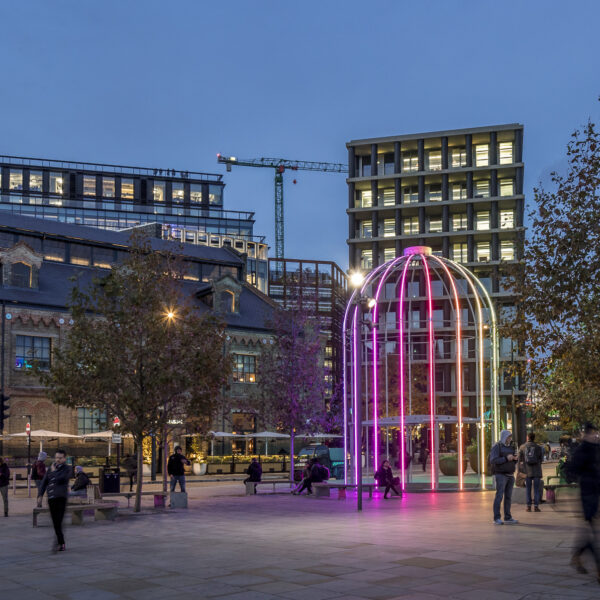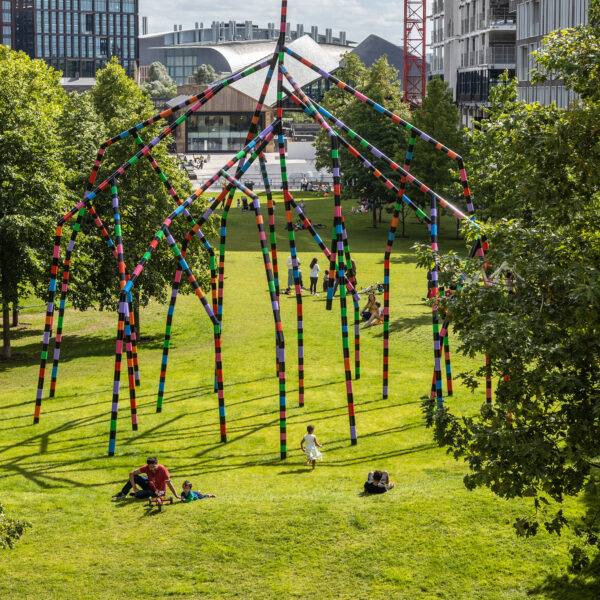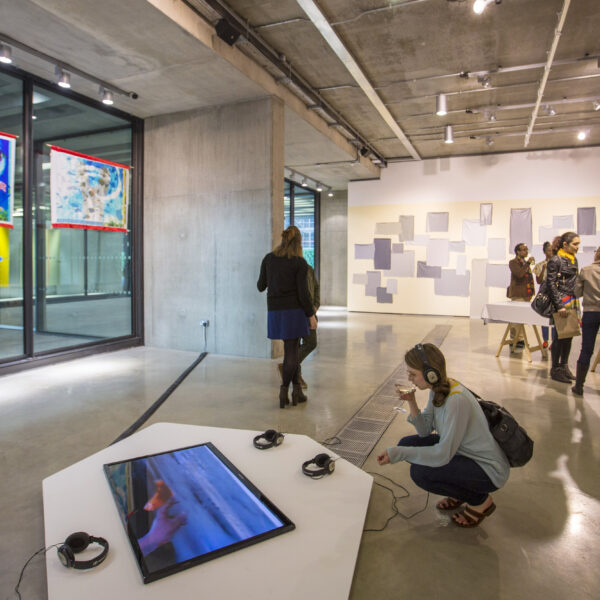A look at the public art pieces that have shaped Kings Cross, with curator Rebecca Heald
Specialising in art, architecture and urban planning, Rebecca Heald is a curator with over two decades of experience. Here, she explores the relationship between Kings Cross and the public art that has shaped the space: from the earliest days when great arching cranes were the primary residents, to the vibrant hub of community and culture it is today.
When it comes to appreciating the value of art and design in public space, I often refer to Frank Pick. Chief Executive of London Transport in the first half of the twentieth century, Pick believed that there was a direct correlation between the quality of our surroundings and our quality of life. When he arrived at London Transport, he was despairing of the network’s disjointed aesthetic. By commissioning the best architects, artists, and designers of his day he sought to generate a more coherent experience for passengers, thereby improving everyone’s impression of the city. Overall, there is little quantitative analysis on the impact of art and design on people’s journey through the urban complex, but in Pick’s time, it is likely that beautiful posters by artists – including Man Ray, Paul Nash, and Laura Knight – meant that more people braved the counterintuitive act of going into the smoky underground, while more recent studies suggest it makes people feel safer.
I first learnt about Pick when working at Art on the Underground, part of Transport for London (TfL), between 2013 and 2016. At TfL, Pick’s legacy continues in multiple ways: good design is at the core of everything they do and the arts retain central importance across the travel network. This model has been taken up across the world, and today many major metropoles have transport-related art programmes. When we began work at King’s Cross in 2015, my co-curator – Tamsin Dillon, former Head of Art on the Underground – and I were keen to investigate how some of Pick’s approach of employing the best creative practitioners of the time could help bring the area to life, and become an integral part of what made this new place somewhere people wanted to be.
Art and culture at Kings Cross
From the earliest days of working on their strategy for King’s Cross in 1999, Argent, the developers, understood the importance of art and culture. Initially, it was envisaged that the 67-acre site might become a kind of gallery that in due course would become ‘an international destination for the arts’. Situating the world-renowned art and design college Central Saint Martins at the centre of the development marked an ambition to prioritise and incubate creativity and innovation in all plans and endeavours. The new King’s Cross area was never a development for which hoardings went up and everything was built out of sight before a grand ‘ta-dah!’ moment. People have always been actively welcomed and encouraged to see what is happening, to enjoy the cranes and the scaffolding, to tread the grounds of this new part of the city. Early on, in 2010, sculptor Graham Hudson was appointed as an artist-in-residence. Hudson marked the 181 days of his residency by creating a sculpture from materials he found on site each day. This was before the builders had even started.

Acknowledging arts commissioning as a distinct expertise, Argent later appointed an Arts Panel to advise on how to formalise and deliver an arts programme. The panel decided to appoint curators to work on a series of commissions. The first to be charged with this brief were Stéphanie Delacroix and Michael Pinsky. Under the umbrella title Relay, they commissioned a series of temporary artworks that successfully encouraged people to venture north of the station, previously only attempted by dedicated clubbers. For Relay, Jacques Ravel made IFO (Identified Flying Object) (2011), a giant birdcage, lit up with different coloured neon by night, which proved so popular it still sits in a prominent position at Battle Bridge Place. Felice Verini’s Across The Buildings (2013) used a mirrored zigzag to bounce light around the façades of Granary Square. Richard Wentworth, a long-time local resident, worked with Swiss architects GRUPPE on Black Maria (2013), a temporary theatre for events and discussions. The series’ finale was Of Soil and Water: King’s Cross Pond Club (2015), the UK’s first man-made natural swimming pond, created by Ooze Architects and artist Marjetica Potrč, for visitors to swim in while watching buildings spring up around them.

Tamsin and I began work at King’s Cross when it was entering a subsequent phase. People were getting used to being in this new part of town, more buildings were now finished and occupied, and as the evolution and purpose of the various open spaces became clearer, there was an aspiration towards permanence. A desire to give something tangible to all those who inhabited and visited the site took hold, something that could become part of their experience and their evolving memories of the place became stronger.
As a curator, I was keen to test what role art and artists could play in making a place into a space. Across the world, hundreds of new cities were emerging, many from scratch, and we had questions about the role art and culture could and should play in ensuring that they didn’t all feel the same. We also wanted to help a progressive developer think imaginatively about how they might best invest in the arts. So we chose the title ‘The King’s Cross Project’ for our work, to try and convey our commitment to research, experiment, and testing. Rather than start a modish corporate art collection, we advocated for an integrated approach, with artworks inserting themselves wholly into the place they were made for.
Accompanying commissions in buildings, and some temporary interventions, there was a remit for something permanent in the public realm. In setting out our plans, we were acutely conscious of what it means to make something ‘forever’, as well as how we might negotiate this in the context of somewhere that was still evolving: nobody really knew what N1C would look or feel like when ‘finished’.
What art can do
Our cities and towns are punctuated with statues and monuments made as reminders of inherited histories. Every day people walk past bronzes of men on horses without even realising, let alone knowing who they are – although this is changing in the current wave of Black Lives Matter protests. While these objects – until recently – may have slipped into people’s unconscious, learning about them can often be lengthy and require proper involvement, hitting upon nationalist agendas and the aggrandising of occasionally dubious characters.
Throughout the twentieth century, art in shared spaces moved beyond the visualisation of national histories and celebration of individuals and became more about trying to capture something of the spirit of the time and the place for which it was made. It also became part of bigger conversations about the nature of institutional exhibition spaces and notions of access and democratisation. Perhaps the best-known example of so-called public art in London currently is the Fourth Plinth: with a rolling programme of experimental sculptural interventions in London’s iconic Trafalgar Square it provides a stark contrast to the commemorative figures on adjacent plinths.
The function or meaning of the art that was envisaged for the arts programme at King’s Cross was appropriately open: no pre-identified person or event was to be highlighted. Employing the site as a testbed for what might be possible in commissioning art for public spaces has resulted in a series of affirmations and discoveries, which can be summarised as follows.
I) Work can animate
The first artwork we installed was Rana Begum’s No. 700 Reflectors (2016) in Lewis Cubitt Square, a 50-metre-long hoarding covered with 35,000 reflectors. Before making the work, Rana was already familiar with the space: she knew it from going there to play in the fountains with her kids, where just around the corner from Granary Square it was often a little calmer. Rana understood the civic nature of the location and the myriad of purposes it had to fulfil. Responding to the brief, she made a structure that brought its surroundings to life, night and day.
A couple of Christmas trees for Granary Square have also been realised in this vein. The first, Joanne Tatham and Tom O’Sullivan’s playful Does the Iterative Fit (2017), using sound spoke and sang and went on to have other lives at Turner Contemporary in Margate and Konsthall Oslo. The second, David Batchelor’s King’s Xmas (2019), was quasi-camouflaged in the daytime thanks to its scaffolding support, but at night its neon shapes shone bright, reflecting in the jumping fountains at its base.
II) Sometimes just be beautiful
Tobias Rehberger’s Almost Everybody (2018) was made especially for WilkinsonEyre’s Gasholders, a residential development at King’s Cross. The work comprises 41 drop-shaped glass lamps in five different colours. Suspended from the ceiling, they are inspired by the Gasholders’ hand-made cast-iron frames. The installation extends beyond the physicality of the lamps, and depends on the building’s inhabitants to exist; with every person that comes in or goes out, lights come on and lights go off.
Almost Everybody exists in the context of Tobias’s wide-ranging practice and relates to other light pieces he has designed, as well as his employment of dazzle camouflage. It can also be understood as a simple, hopeful celebration of craft and colour.
III) Relay histories
As suggested earlier, an accepted role of art in public is that it can tell or relay histories. Two works commissioned as part of The King’s Cross Project explicitly do this: Tess Jaray’s Aleppo for King’s Cross (2016) and Amalia Pica’s Semaphores (2019).
Tess’s ‘wall sculpture’ in the Tapestry building marked a turning point in her interpretation of her own work. Born of a visit she made to Aleppo before the conflict in Syria broke out, the shapes and colours of the piece are derived from her memories of the city’s architecture, the materials used and the shadows cast. To begin with, her explanation of Aleppo was abstract and formal, but as the war intensified the light and the dark of the work came to carry a strong metaphor, in her words connecting ‘the visual with the heart’.
Meanwhile, Amalia’s Semaphores tapped into the history of King’s Cross while alluding to its present. Semaphore is a code that was used in early telegraphy to send text-based messages across long distances in visual form. By making it the subject of her sculptures at King’s Cross, the artist references a range of histories, including that of railway signalling, while simultaneously pointing to the area’s
current role as a hub for technology companies, including Google. Messages, signals and codes swirl through the air as we navigate these spaces and Amalia provides a candy-coloured reminder to stay alert to the powers around us.
IV) Create new narratives
We commissioned Rasheed Araeen to make a new piece for the atrium of the Maki-designed Aga Khan Centre. The 35-metre-high Rhapsody in Four Colours (2018) fills the building’s central wall and celebrates the connection between twentieth-century geometric abstraction and the achievements of Islamic civilisation. Rasheed explains that geometric abstraction in twentieth-century modernist art has its roots over a thousand years ago in Islamic thought and expression, in Umayyad Damascus and Abbasid Baghdad. This is a history that is only just evolving, and it is artworks rather than art historians that are leading the way.
V) Create new spaces
Duggan Morris’s award-winning R7 building has an ‘inside street’ running through it at ground level. Céline Condorelli was invited to create an artwork that could accommodate different kinds of activity – sitting, talking, eating lunch, music recitals, poetry readings. Taking direct inspiration from the stage Italian architect Lina Bo Bardi constructed for the now legendary restaurant Zanzibar in Salvador da Bahia, Brazil, Céline devised three ‘units’ that are strongly tied to traditions of tropical modernism, combining concrete and lush vegetation. People who work in the building speak enthusiastically about how the structures have become a favourite spot for meetings and conversations. 
And, of course, now Eva Rothschild’s new sculpture can be understood in this way too, as creating new space.
My World and Your World
The title of Eva’s new sculpture at King’s Cross, My World and Your World, is an invitation to consider the potential of art in the public sphere. The work brings to the fore ideas about shared spaces and shared experiences, and how these can be created and enabled. The anticipation is that the people who live here, work here, and passers-by will develop a relationship with this new artwork and that they will each come to feel a sense of ownership of it. And, crucially, in research terms, that it will help us appreciate the role artists might play in shaping city spaces.
Being a permanent sculpture, there is much in the work that breaks with expectations: this is not a big, solid piece of bronze that acts as an indicator of power, rather it is an open, porous structure with a colourful frame. What is more, it is created by a woman – regrettably something of note in an art world still dominated by men.
Notes for the future
For all those artworks that have come to fruition, there are also many artworks that haven’t materialised. When working in a live environment, where plans and materials are in constant flux, this is to be expected. What is important is that art and artists are part of the conversation and that the conversation starts as early as possible.








